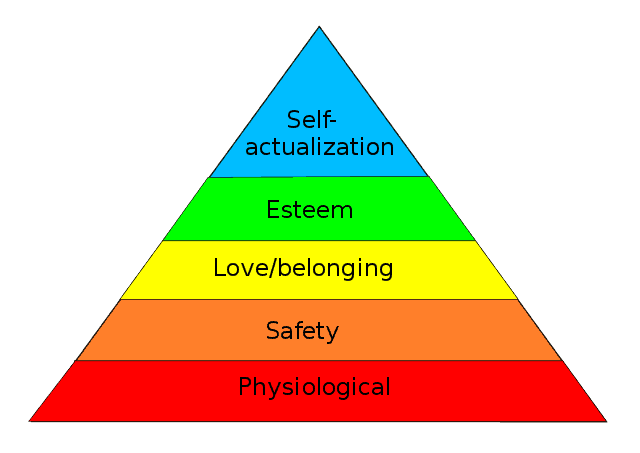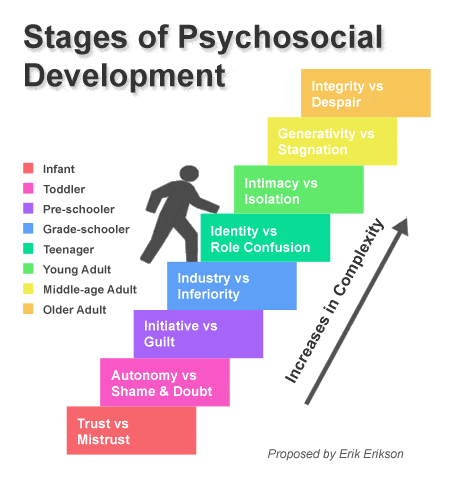Stages in development are widely accepted and provide a typical approach in psychological and social studies. Three of the most important were developed by Abraham Maslow, Lawrence Kohlberg, and Erik Erikson. Their insights, although sometimes altered, underlie the Mental Construction view of the Development of the Adult Mind.
Maslow shows the 3S Imperatives at his pyramid’s base. Kohlberg highlights that morals shift over development years. In the same developmental years, Erikson defines psychosocial tasks we are grappling with.
Maslow

Figure 25.1 By FireflySixtySeven – Own work using Inkscape, based on Maslow’s paper, A Theory of Human Motivation., CC BY-SA 4.0, https://commons.wikimedia.org/w/index.php?curid=36551248
Maslow’s pyramid of needs addresses mature adults. Below, I’ve interwoven some consideration of the person’s age.
The base in Abraham Maslow’s pyramid, the physiological needs arise from genetic instructions, not conscious reflection. They arose in our predecessor organisms and are exhibited by every infant.
The need for safety arose when organism realized that certain dangers accompanied certain actions–that is when memory developed. Humans aren’t born with such memory. Until the myelination of the hippocampus occurs between ages 3 and 6, young children only have short-term memory. With the hippocampus, memories are formed allowing the child to relate situations, actions, and consequences, to notice situations that portend danger and the need for circumspect behaviors.
The Belongingness stage occur when children have memory as well as the dawning recognition that they have action choices.
All of us have a level of self-esteem built upon whatever success we have in the lower levels as well as the treatment we experience.
Some people reach the peak of Self-Actualization, depending on their success with the supporting needs.
Maslow’s pyramid exhibits the precedence used in our decision-making. Satiety is first. Although the pyramid doesn’t explicitly list it, sex is second, then the pyramid lists safety. Next above in our behavioral decisions to satisfy our needs are the effect on our social relationships, then our self-esteem, and finally utilizing our full potential.
The top three tiers are muddier when we consider our cortical brain can override the tentative decisions that our limbic system suggests. In addition, our knowledge of the effect of our actions and their consequences is often shaky, leaving choices trial-and-error.
Kohlberg

Lawrence Kohlberg (Figure 25.2) highlighted morality changes over our development into adulthood. That our morality changes may sound shocking and wrong until we consider how our situation changes over our lifetime.
- In infancy, we chose whatever activity avoids punishment. Obedience to an external rule is the morality.
- Pre-school age, we chose activities that reward with pleasure. Self-interest becomes our morality.
- During the younger school years, we strive to conform to the norms of our social group. Conformity is our mortality.
- In later school years, we strive to follow the abstract rules we are taught that guide our society. Fitting into wider society guides our choices, becomes our morality.
- As teens, we see that morally and legally right do not always align. Decisions are made pragmatically, weighing individual benefits and possible effects on others.
- As adults, morality is based on principles that transcend individuals.
Kohlberg’s individual stages in a particular order at general age ranges has influenced my view, although Development to Adult Mind will reveal various differences in detail and emphasis.
Erikson
Erik Erikson developed (in Figure 25.3) an influential chart of the stages that people struggle through. There is a specific order along with age ranges that the task occurs at.

Source Erikson’s Stages of Psychsocial Development. Zanl13
The excellent chart (Figure 25.3) makes it visually clear that the stability of each ascending step depends on the completion of those below it. The more firm the supporting steps, the more stable the subsequent steps. Nevertheless, with the steps offset, the uppermost steps often are on shaky support. Not all steps will be successfully mounted by every person.
The titles of the steps (Trust vs Mistrust, Autonomy vs Shame & Doubt, Initiative vs Guilt, etc.) show the difference between Erikson’s interest and that of generic mental development (developing one’s own thought patterns, learning categories, others have their unique thoughts, etc.)
Verbal perspective aside, Erikson’s stages highlight mental tasks which are common across humanity. It outline the shapes of the thoughts we are incorporating in our internal world, whether by personal experience, cultural categories, or by assuming what others think.
Return to Development to Adult Mind
Proceed to Cognition